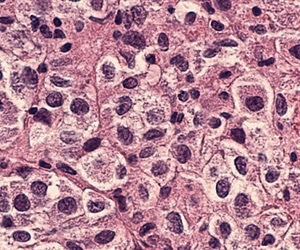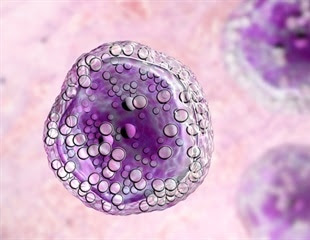| | _on_a_T-cell_is_binding_to_a_molecule_on_a_cancer_cell_surface_-Alpha_Tauri_3D_Graphics_3c454d0be6cd404da8416f3321898014-310x240.jpg) Researchers at Brigham and Women’s Hospital quantified the neurological symptoms associated with CAR T-cell therapy and found that 77 percent of patients receiving the treatment experienced at least one neurological side effect. Researchers at Brigham and Women’s Hospital quantified the neurological symptoms associated with CAR T-cell therapy and found that 77 percent of patients receiving the treatment experienced at least one neurological side effect. | |
|
| |  Chimeric antigen receptor T cells are genetically modified to target specific cells; they have been used in research-based cancer treatments. Treatment is associated with numerous side effects and research is being performed on how to reduce them. Chimeric antigen receptor T cells are genetically modified to target specific cells; they have been used in research-based cancer treatments. Treatment is associated with numerous side effects and research is being performed on how to reduce them. | |
|
| |  Antinuclear antibodies (ANA) are autoantibodies directed against the nuclei of some of one’s own body cells. They are present in the blood in persons with certain autoimmune disorders. Antinuclear antibodies (ANA) are autoantibodies directed against the nuclei of some of one’s own body cells. They are present in the blood in persons with certain autoimmune disorders. | |
|
| |  The recent advent of chimeric antigen receptor (CAR) T-cell therapy has revolutionized the clinical treatment of cancer. The recent advent of chimeric antigen receptor (CAR) T-cell therapy has revolutionized the clinical treatment of cancer. | |
|
| |  The ever-changing "head" of an influenza virus protein has an unexpected Achilles heel, report scientists funded by the National Institute of Allergy and Infectious Diseases, one of the National Institutes of Health. The ever-changing "head" of an influenza virus protein has an unexpected Achilles heel, report scientists funded by the National Institute of Allergy and Infectious Diseases, one of the National Institutes of Health. | |
|
| |  A new slow-release vaccine has been shown to boost the immune system’s response to the HIV virus. The vaccine is given in small doses over a period of days, compared to one large dose. A new slow-release vaccine has been shown to boost the immune system’s response to the HIV virus. The vaccine is given in small doses over a period of days, compared to one large dose. | |
|
| |  Immunologists at The University of Texas at Austin have recorded visuals of T-cells learning what kind of cells to ignore when fighting pathogens, to ensure they do not attack healthy cells and tissues when fighting disease. It is the first time that this process has been captured on video. Immunologists at The University of Texas at Austin have recorded visuals of T-cells learning what kind of cells to ignore when fighting pathogens, to ensure they do not attack healthy cells and tissues when fighting disease. It is the first time that this process has been captured on video. | |
|
| |  Insights into the genes and proteins involved in the predatory behavior of a parasitic yeast species could lead to new strategies for controlling yeast pathogens, according to a study published May 9 in the open-access journal PLOS Pathogens by Jürgen Wendland of the Carlsberg Research Laboratory in Denmark and Vrije Universiteit Brussel in Belgium, and colleagues. Insights into the genes and proteins involved in the predatory behavior of a parasitic yeast species could lead to new strategies for controlling yeast pathogens, according to a study published May 9 in the open-access journal PLOS Pathogens by Jürgen Wendland of the Carlsberg Research Laboratory in Denmark and Vrije Universiteit Brussel in Belgium, and colleagues. | |
|
| |  Gastric cancer, Q fever, Legionnaires' disease, whooping cough--though the infectious bacteria that cause these dangerous diseases are each different, they all utilize the same molecular machinery to infect human cells. Gastric cancer, Q fever, Legionnaires' disease, whooping cough--though the infectious bacteria that cause these dangerous diseases are each different, they all utilize the same molecular machinery to infect human cells. | |
|
| |  Waldenström macroglobulinemia (WM) is a form of lymphoma characterized by the presence of large amounts of an antibody called macroglobulin. It is also called lymphoplasmacytic lymphoma. The built up of macroglobulin is responsible for the characteristic symptoms associated with WM. Waldenström macroglobulinemia (WM) is a form of lymphoma characterized by the presence of large amounts of an antibody called macroglobulin. It is also called lymphoplasmacytic lymphoma. The built up of macroglobulin is responsible for the characteristic symptoms associated with WM. | |
|
| |  Gastric cancer, Q fever, Legionnaires' disease, whooping cough--though the infectious bacteria that cause these dangerous diseases are each different, they all utilize the same molecular machinery to infect human cells. Gastric cancer, Q fever, Legionnaires' disease, whooping cough--though the infectious bacteria that cause these dangerous diseases are each different, they all utilize the same molecular machinery to infect human cells. | |
|
| |  The cGAS–STING pathway is a part of the innate immune system and is involved in the detection of cytosolic deoxyribonucleic acid (DNA). The cGAS–STING pathway is a part of the innate immune system and is involved in the detection of cytosolic deoxyribonucleic acid (DNA). | |
|
| |  Granulomatosis with polyangiitis (GPA), known as Wegener’s granulomatosis until 2011, is a rare and potentially serious condition that causes inflammation of the small blood vessels and capillaries. It typically affects the ears, nose, sinuses, kidneys, and lungs, and can affect anyone of any age, although it is most commonly seen in middle-aged or elderly people. Granulomatosis with polyangiitis (GPA), known as Wegener’s granulomatosis until 2011, is a rare and potentially serious condition that causes inflammation of the small blood vessels and capillaries. It typically affects the ears, nose, sinuses, kidneys, and lungs, and can affect anyone of any age, although it is most commonly seen in middle-aged or elderly people. | |
|
| |  Acquired immunodeficiency syndrome (AIDS) is a state of severe immunosuppression in which patients are at increased risk for lymphoma. Acquired immunodeficiency syndrome (AIDS) is a state of severe immunosuppression in which patients are at increased risk for lymphoma. | |
|
| |  Breastfeeding is one of the most important natural provisions for the baby’s health and development. This process is regulated largely by nervous and hormonal signals. Breastfeeding is one of the most important natural provisions for the baby’s health and development. This process is regulated largely by nervous and hormonal signals. | |
|
| |  The Zika virus outbreak in Latin America has affected over 60 million people up to now. The infection can have potentially fatal consequences for pregnant women and their unborn children: many children have subsequently been born with malformations of the head, or so-called microcephaly. The Zika virus outbreak in Latin America has affected over 60 million people up to now. The infection can have potentially fatal consequences for pregnant women and their unborn children: many children have subsequently been born with malformations of the head, or so-called microcephaly. | |
|
| |  Biting insects use a range of tools when sucking blood from hosts to maximize their chances of a good meal. Biting insects use a range of tools when sucking blood from hosts to maximize their chances of a good meal. | |
|
| |  The National Institute of Allergy and Infectious Diseases, part of the National Institutes of Health, today announced awards to establish four Cooperative Research Centers focused on developing vaccines to prevent sexually transmitted infections. The National Institute of Allergy and Infectious Diseases, part of the National Institutes of Health, today announced awards to establish four Cooperative Research Centers focused on developing vaccines to prevent sexually transmitted infections. | |
|
| |  Chlamydia is the most prevalent bacterial sexually transmitted infection (STI) in the world. There is no vaccine to prevent infection. However, researchers from the University of North Carolina at Chapel Hill, in partnership with colleagues at other sites in the US, Europe and Australia, will receive up to $10.7 million over five years from the National Institutes of Health (NIH) to move closer to identifying a vaccine candidate. Chlamydia is the most prevalent bacterial sexually transmitted infection (STI) in the world. There is no vaccine to prevent infection. However, researchers from the University of North Carolina at Chapel Hill, in partnership with colleagues at other sites in the US, Europe and Australia, will receive up to $10.7 million over five years from the National Institutes of Health (NIH) to move closer to identifying a vaccine candidate. | |




_on_a_T-cell_is_binding_to_a_molecule_on_a_cancer_cell_surface_-Alpha_Tauri_3D_Graphics_3c454d0be6cd404da8416f3321898014-310x240.jpg)








































.png)











No hay comentarios:
Publicar un comentario